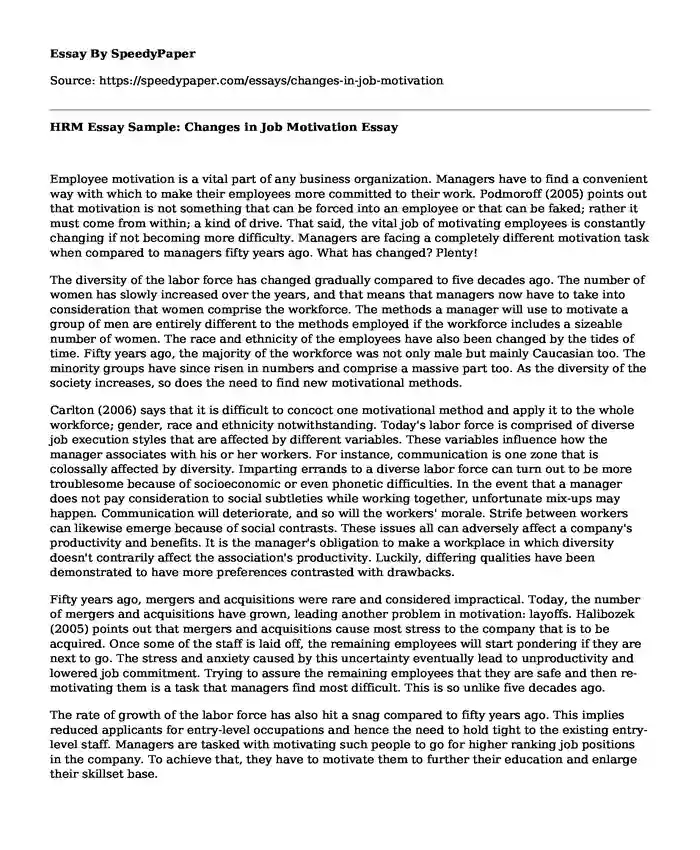
| Type of paper: | Essay |
| Categories: | Management Human resources Motivation |
| Pages: | 3 |
| Wordcount: | 665 words |
Employee motivation is a vital part of any business organization. Managers have to find a convenient way with which to make their employees more committed to their work. Podmoroff (2005) points out that motivation is not something that can be forced into an employee or that can be faked; rather it must come from within; a kind of drive. That said, the vital job of motivating employees is constantly changing if not becoming more difficulty. Managers are facing a completely different motivation task when compared to managers fifty years ago. What has changed? Plenty!
The diversity of the labor force has changed gradually compared to five decades ago. The number of women has slowly increased over the years, and that means that managers now have to take into consideration that women comprise the workforce. The methods a manager will use to motivate a group of men are entirely different to the methods employed if the workforce includes a sizeable number of women. The race and ethnicity of the employees have also been changed by the tides of time. Fifty years ago, the majority of the workforce was not only male but mainly Caucasian too. The minority groups have since risen in numbers and comprise a massive part too. As the diversity of the society increases, so does the need to find new motivational methods.
Carlton (2006) says that it is difficult to concoct one motivational method and apply it to the whole workforce; gender, race and ethnicity notwithstanding. Today's labor force is comprised of diverse job execution styles that are affected by different variables. These variables influence how the manager associates with his or her workers. For instance, communication is one zone that is colossally affected by diversity. Imparting errands to a diverse labor force can turn out to be more troublesome because of socioeconomic or even phonetic difficulties. In the event that a manager does not pay consideration to social subtleties while working together, unfortunate mix-ups may happen. Communication will deteriorate, and so will the workers' morale. Strife between workers can likewise emerge because of social contrasts. These issues all can adversely affect a company's productivity and benefits. It is the manager's obligation to make a workplace in which diversity doesn't contrarily affect the association's productivity. Luckily, differing qualities have been demonstrated to have more preferences contrasted with drawbacks.
Fifty years ago, mergers and acquisitions were rare and considered impractical. Today, the number of mergers and acquisitions have grown, leading another problem in motivation: layoffs. Halibozek (2005) points out that mergers and acquisitions cause most stress to the company that is to be acquired. Once some of the staff is laid off, the remaining employees will start pondering if they are next to go. The stress and anxiety caused by this uncertainty eventually lead to unproductivity and lowered job commitment. Trying to assure the remaining employees that they are safe and then re-motivating them is a task that managers find most difficult. This is so unlike five decades ago.
The rate of growth of the labor force has also hit a snag compared to fifty years ago. This implies reduced applicants for entry-level occupations and hence the need to hold tight to the existing entry-level staff. Managers are tasked with motivating such people to go for higher ranking job positions in the company. To achieve that, they have to motivate them to further their education and enlarge their skillset base.
The changes in challenges faced by managers will continue to evolve as the different dynamics of the working industry change. In fifty years, the motivational methods used today will be archaic and irrelevant. Managers must adapt to the wheels of time and change.
References
Podmoroff, D. (2005). 365 ways to motivate and reward your employees every day--with little ornoMoney. Atlantic Publishing Company.
Carlton, M. (2006). The power of more than one: Success strategies from Australasia's leadingbusinessand motivational specialists. Hamilton, N.Z: Phantom Pub.
Halibozek, E. P., & Kovacich, G. L. (2005). Mergers and acquisitions security: corporaterestructuring and security management. Butterworth-Heinemann.
Cite this page
HRM Essay Sample: Changes in Job Motivation. (2017, Aug 29). Retrieved from https://speedypaper.com/essays/changes-in-job-motivation
Request Removal
If you are the original author of this essay and no longer wish to have it published on the SpeedyPaper website, please click below to request its removal:
- Free Essay: Breaking the Barriers and Comprehension for Middle Schools
- Essay Sample: Keeping Customers Happy in John Lewis Partnership
- Free Essay Sample on the Rocky Horror Show
- IKEA's Marketing in China, Essay Sample
- Traditional Ideologies, Politics Essay Example
- The Mexican Ancestry, Essay Example for Students
- To the University College Absalon. Paper Example
Popular categories




